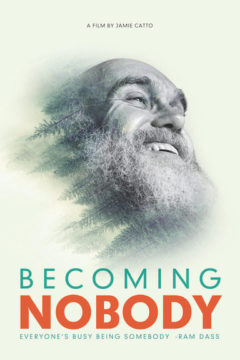Film Review: Becoming Nobody

As one of the most influential spiritual teachers of our time, Ram Dass has had a number of films made about him. Director Jamie Catto takes a personal approach to this documentary, part of which is built around a conversation between the two men. Catto himself had his life changed by Ram Dass, and wants to thank the sage, now in his late 80s and ailing, for his wisdom.
Beyond their dialogue, Becoming Nobody also takes in Ram Dass’s life story, mainly through archival clips of his earlier appearances. It is a fascinating journey, involving early experiments with drugs and abortive attempts at a kind of enlightenment that nevertheless denied the reality of his own psychology. The journey is critical to understanding how his philosophy developed. Ram Dass describes the self as a kind of suit that we are forced to wear, and its boundaries are fortified whenever we see ourselves as a being separate from others or try to define others. It can take a lifetime to shed that suit or to realize that maybe it was never there to begin with.
The film dedicates the bulk of its running time to allowing Ram Dass to explain his ideas, which comes as a relief, because they are surprisingly complex (though Ram Dass himself might disagree). The title of the film, “Becoming Nobody,” refers to the ideal state of being that Dass espouses, that of shedding one’s ego and sense of self and becoming one with the totality of the universe. “When you make yourself into zero, that’s when your power is unbelievable,” he explains. In this state, we neither grab at life nor push it away; indeed, there is nothing we can turn away or embrace. It’s a powerful idea, and one that requires new ways of speaking, describing, and even thinking about human experience. While Ram Dass is a charming presence, the film is at its best when Catto tries to illustrate his teacher’s ideas through clever montages of representative imagery and music. Maybe such artful deployment of technique goes against the simplicity that Ram Dass preaches—but it often makes for moving cinema.






